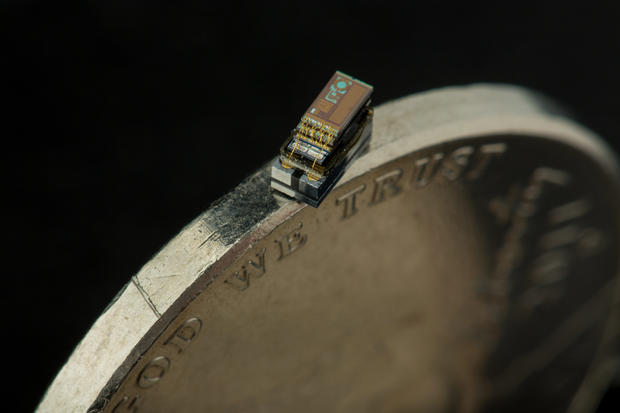This is the world's smallest computer
Computers used to consume whole rooms, but now one computer can fit on the edge of a nickel. At just one millimeter cubed, the Michigan Micro Mote (M^3) is the smallest autonomous computer in the world.
For over a decade, the faculty and students at the University of Michigan's computer science department have been working on the M^3. As the Internet of Things (IoT) gets bigger, the Michigan team is pushing to make computers ever smaller.
"The Internet of Things describes a world in which everyday common objects have intelligence - like a toaster, a washing machine, or doorknob. All of those things will someday have integrated circuits in them that can talk to each other over a network," said Dag Spicer, senior curator at the Computer History Museum in Mountain View, Calif.
Despite its tiny size, the M^3 has the ability to take pictures, read temperatures and record pressure readings. Researchers hope to implement the microcomputer into a variety of applications ranging from medical to industrial purposes. Due to its micro-size, the M^3 can actually be injected into the body, where it can then perform ECGs and also take pressure and temperature readings. The oil industry is also interested in inserting the Micro Mote into oil wells to help detect pockets of oil that can still be extracted before moving on to new sources.
The Michigan faculty sees the Micro Mote as a way to never lose anything again. The vision is that people would buy a couple of M^3s and stick the computers to their keys, wallet, and anything else they don't want to lose. And using a central system, people would be able to locate their belongings within the confines of their home.
As the tech industry pursues the IoT movement, size and power are everything. In order to make the micro mote as unobtrusive as possible, the scientists had to find a way to scale down the computer's battery size.
"What people don't realize is a very large part of the volume of a computer for instance in a cellphone is actually consumed by the battery," said David Blaauw, professor of electrical engineering and computer science at the University of Michigan. "So by bringing down the power, we can bring down the battery size, and we can bring down the whole system down in size."
With no space for a keyboard, mouse or display, the faculty and students had to invent a different way to communicate with the micro mote. The M^3 is programmed and charged via light. By strobing light at a high frequency, the operator is able to send information to the computer. Once the Micro Mote processes the data, it is able to send the information to a central computer via conventional radio frequencies.
The M^3 is ready for production now, the faculty and staff are already looking forward to creating even smaller computers, which they call smart dust.
"Going forward there's no reason you can't keep pushing that. Can't get to a hundred microns on a side. And then you can get chips inside cells," said Dennis Sylvester, also a professor of electrical engineering and computer science at the University of Michigan. "It's an easy thing to see as, you know, making science fiction a reality."
